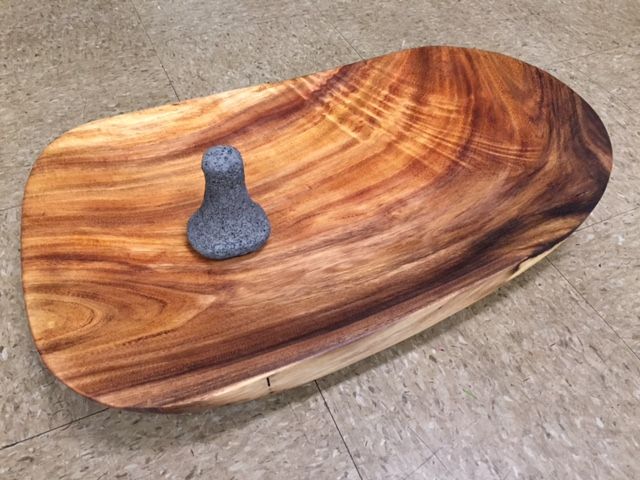By participating in collective efforts within communities to improve education systems, Kamehameha Schools helps cultivate a strong Native Hawaiian identity among our learners, fostering within them the confidence and resiliency to thrive.
Kamehameha Schools, in collaboration with Hawaiian culture-based community education program Keiki O Ka ʻĀina, is hosting Punaluʻu Ahupuaʻa Farms’ first-ever Board & Stone Class.
The family-based cultural experience teaches the Hawaiian tradition of hand-carving a papa kuʻi ʻai (poi board) and a pōhaku kuʻi ʻai (stone poi pounder) with natural materials gathered from the land. The class is taught by Kumu Earl Kawa‘a, a Hawaiian resource specialist with KS and revered cultural practitioner from Molokaʻi who teaches time-proven methodologies of sustainability that have served Hawaiians for generations. Forty families from the Ko‘olau Region are expected to participate in the class, which takes place on Saturdays from March 11-May 27.
“The Punalu‘u Board & Stone experience brings together our lands, traditions and the voice of the community,” says KS Ko‘olau Regional Director Jamee Miller. “This is an exciting and transformational time for KS as we respond in practical ways that support Vision 2040, where the ‘ohana is at the center of a thriving lāhui.”
Kawa‘a’s dedication to sharing this knowledge came in an epiphany years ago when he returned to Kilohana – a town in East Molokaʻi – where he attended school as a keiki.
“I had to bring eighteen boards and eighteen stones with me because they didn’t have any,” Kawa‘a explains. “I was so hurt because I grew up on Molokaʻi where there was a board and stone in every home. It was a heart-breaking experience, and I said to myself ‘the loss of these boards means the demise of Hawaiian culture as well.’”
From this experience, Kawa‘a coined the phrase “one board, one stone in every home,” and in 2010, he supplemented his work at KS by teaching families how to make them. Since then, in conjunction with Keiki O Ka ʻĀina, the kumu has taught multiple Board & Stone classes in Waimānalo, Wai‘anae, Kalihi Valley, Papakōlea and will do so for the first time in Punaluʻu.
“The class is about so much more than just making a board and stone,” says KS Land Asset Manager Joey Char. “It’s a way of bringing families together in a safe environment for learning and empowerment. It’s an opportunity for parents and children, aunties and uncles, brothers and sisters to share a culturally profound and meaningful experience. And, it’s a lot of fun!”
For more information on the Board & Stone Class, and to learn about the history of the ahupua‘a and other activities in Punalu‘u, log on to www.ksbe.edu/punaluu.
STRATEGIC PLAN 2020
SP2020 is a five-year strategic plan that will guide Kamehameha Schools from 2015 to 2020. The plan marks a starting point toward KS Vision 2040, which envisions success for all Native Hawaiian learners.
Kamehameha educators across the state support Goal 2 and Goal 3 of SP2020, which call for KS to: contribute to communities’ collective efforts to improve education systems for Native Hawaiians; and cultivate a strong Native Hawaiian identity in learners for the betterment of the lāhui. The Board & Stone Classes align with Actions 4 and 5 of Kamehameha’s Ten Actions for fiscal year 2017, which call for KS to leverage community partnerships and integrate cultural principles system-wide.
A Board & Stone in Every Home
As part of the Board & Stone Class in Punalu‘u, some of the practices each family will learn include:
• Writing their own oli, or protocol, that asks the land to share its bounty and provide them with the materials needed for the class.
• Using hao tree branches to make koʻi, the adze used to carve their board.
• Choosing the raw slab of wood for their papa kuʻi ʻai (poi board).
• Walking the banks of Punaluʻu stream to find and select the stone they will transform into their pōhaku kuʻi ʻai (poi pounder).
• Learning the different strokes and carving techniques.
• Lu‘ukai (purifying the papa kuʻi ʻai in the ocean) and Paʻakai (the importance of salt in culture, food and ceremony).
• Harvesting kalo from the Punalu‘u lo‘i.
• A celebratory hōʻike where families will name their board and stone, then use them to pound taro into paʻiʻai as part of a potluck lūʻau.

TAGS
punaluu ahupuaa farms,
sp2020 goal 3,
sp2020 goal 2,
16-17action4,
16-17action5,
hawnculture
CATEGORIES
Kaipuolono Article, Themes, Community
Print with photos
Print text only










